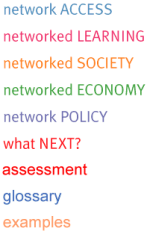The technological gains of the last several decades lie at the core of staggering new surges of wealth and well-being within the richest countries of the world. Electronic commerce and related applications of information and communication technologies (ICTs) have become tremendous engines for economic growth and productivity and are changing the shape of the world in which we live. Yet the developed world is reaping the vast majority of these gains. It is our view that the appropriate use of information and communication technologies can also improve the lives of the 80% of the world's population that lives in the developing world. The great divide between rich and poor countries, long observed with regard to economic wealth and social conditions, is equally prevalent and worrisome in the realm of information and communication technologies. While the growth of the Internet and the continuing "digitalization of society" are much heralded events in more developed countries, many leaders in developing nations are left wondering how they can participate in the rapid changes going on around them. How can ICTs help their businesses, governments and communities become more productive? How do they get ready for the Networked World? We believe that there now exists a unique opportunity for many of these communities to join global information networks to propel them to greater wealth and prosperity. Without a concerted effort by the developing world to get ready for the global networked economy, however, the gaps in living standards between developed and developing countries will only grow wider, and the productive use of these technologies will remain a phenomenon that is largely confined to the richest parts of the world. Building upon earlier work by the Computer Systems Policy Project (CSPP) on Global Electronic Commerce Readiness, and with the support of IBM, we have created a systematic but flexible approach to assessing Networked Readiness. This Guide is a tool that provides the first step in creating a strategic approach to planning for developing world communities. Our collective understanding of Networked Readiness is still in its infancy, particularly with respect to the largely untapped markets and resources of the developing world. The landscape is shifting rapidly, and we recognize the challenge of creating a methodology that must serve diverse communities and apply to a rapidly evolving subject matter. To that end, the Guide is a general framework that each community should tailor to its own needs. It should be used not for comparison among communities, but for appraisal within them. It is our hope that Readiness for the Networked World: A Guide for Developing Countries will become a valuable resource that businesspeople, policy-makers, community leaders and others will use to unlock the tremendous potential that ICTs hold as a catalyst for development. It is not an easy task, for there exist myriad obstacles to Readiness, but with hard work and cooperation among the public, private, and non-profit sectors, we believe that the communities in the developing world can begin to better capture the benefits of the Networked World. Jeffrey D. Sachs Director <---Previous Page Next Page -->
|
|||



